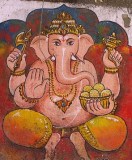In a previous Foundations post, I described the main qualities of Kapha dosha (the energy of Earth and Water): heavy, slow, cool, oily, liquid, slippery/smooth, dense, soft, and stable.
In human beings, Kapha’s primary responsibility is creating structure, stability and lubrication. When Kapha is in balance (i.e., when it is maintained at the original baseline level set at an individual’s birth), then that person enjoys a sense of groundedness, stamina and compassion.
When Kapha dosha gets elevated, however, then excess mass or liquid can start to cause problems. Imbalances connected to the element of Water such as congestion, excess mucus, edema, and weight gain can occur, as can Earth element issues like cysts, tumors, gallstones, diabetes, and kidney stones.
In the mind and heart, excess Kapha can make a person feel lethargy, fatigue, “stuck in a rut,” a lack of clarity, or overly attached, greedy and possessive.
What causes Kapha dosha to elevate? Exposure to Kapha’s qualities (in the immediate environment around you, in foods consumed, or in the environment of the mind) will cause Kapha to rise in accordance with the law of “like increases like.”
Kapha-increasing foods are heavy, oily and sweet, like dairy, fried foods, meat, cake and ice cream. Cold and moist climates, iced drinks, sedentary lifestyles, napping during the day and sleeping in a soft bed can all increase Kapha.
Kapha is most present in the early years of childhood when our bodies are responsible for growth and building. Kapha is also high in the damp, wet season of Spring, when allergies often unleash a torrent of Kapha phlegm.
The best “medicine” for Kapha contains its opposite qualities: light, sharp, fast, warm, dry, rough, and mobile. It is of the utmost importance for Kapha types to engage in plenty of exercise and movement, avoid cold and heavy food, cook with ginger, chilis and black pepper, and cultivate devotion through chanting and yoga.
* * * * *
Join me for a free webinar “Deepen Your Yoga with Ayurveda” on Tuesday, Aug. 21, at 7pm CDT (8pm EDT, 5pm PDT). Register and get more information here: http://ivyingram.com/free-webinars/





